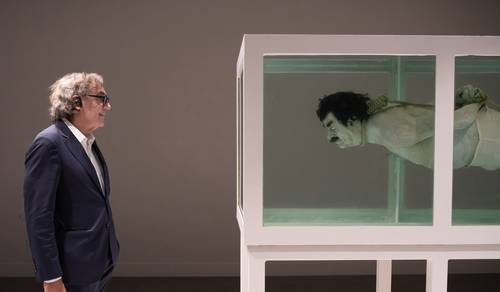The Museu de l’Art Prohibit shows censored works collected by Taxto Benet
Barcelona The new Museum of Prohibited Art, which is located in Casa Garriga Nogués in Barcelona, exhibits censored works
collected in the last five years by its promoter, the journalist and businessman Tatxo Benet, and which in a first presentation exhibits 42 of the 200 pieces that he collected.
At a press conference last Tuesday, Tatxo Benet assured that the venue, which opens its doors today, is only one in the world
. During the museum tour he stressed that the works are as important as the history behind them.
The director of the museum, Rosa Rodrigo, stated that the Benet collection is very unique, with works that have been censored or removed from exhibition at some point
which consider all types of disciplines and a time span from the 18th to the 21st centuries with pieces that dialogue with each other.
In this first exhibition, which will change every 10 months or a year with between 40 and 50 pieces, is the project Amenby Abel Azcona, who was denounced for desecration; Not dressing for conquering/HC04 Transportby Ines Doujack, with a male figure that could be identified with the king emeritus and that was temporarily removed from an exhibition at the Museum of Contemporary Art of Barcelona, and McJesusby Jaine Leinohen, a crucified Ronald McDonald that was removed from an exhibition in Israel.
It also includes works such as Mao, by Andy Warhol, which did not appear on a tour of China; the Serie Suite 347by Pablo Picasso, which the Russian Church condemned as erotic; The statue of a Girl of Peaceby Kim Eun-Sung and Kim Seo-Yung, which has caused diplomatic incidents between South Korea and Japan, and the work Piss Christby Andres Serrano, who has been attacked on numerous occasions.
The new museum exhibition also contains the sketch Floating nude with outstretched armsby Gustav Klimt, from a canvas that was burned during World War II and was branded pornographic, and Filipo Strozzi in Legoby Ai Weiwei, portrayed along with three other classic Italian characters who were deprived of their freedom.
The exhibition, which occupies 2 thousand square meters, opens with the diptych Sharkby David Cerny, a full-scale reproduction of Saddam Hussein’s corpse in a tank of folmaldehyde, and Always Francoby Eugenio Merino, a work for which the artist was sued and won the trial.
Despite the acquisition of the work in 2018 Political prisoners in contemporary Spainby Santiago Sierra – which is not in the museum, but is on loan to the Museu de Lleida –, Benet has said that the idea of putting together a collection around censorship did not come to him until after purchasing a piece by Zoulikha Bouabdellah.
Reference for Europe
The museum’s artistic director, Carles Guerra, added that the center is a ambitious exercise
of transforming a collection into a story, and has stressed that it may be destined to be one of the reference private collections in Europe, also as a center for censorship studies.
At the inauguration, the president of the Generalitat, Pere Aragonès, stressed that, if anywhere in the world it makes sense for there to be a museum dedicated to censorship and prohibited art, it is in Catalonia, a city and a country that have been bastions of freedom of expression, creative and cultural
.
Aragonès has pointed out that this new museum challenges the defense of creative freedom and the limits of freedom of expression, and has stressed that the museum is a “cry in favor of this freedom.
Betting on culture is betting on freedom
said Aragonès, applauding the initiative promoted by Tatxo Benet.
